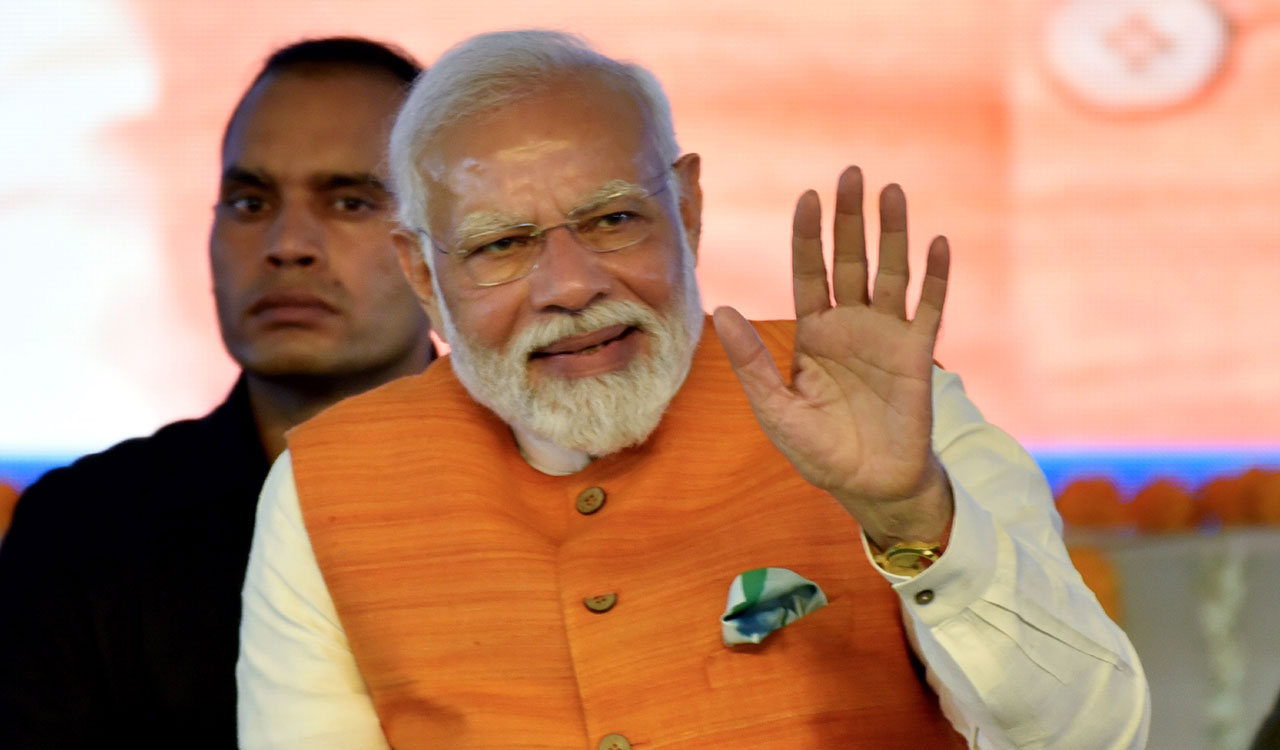
While these two projects were without doubt an attempt on damage control after giving the very same demands the cold shoulder for 10 years, Modi tried a little more to douse the fire over the continued neglect from the Centre towards Telangana
Published Date - 07:43 PM, Sun - 1 October 23
Hyderabad: Clearly shaken by the fact that the Bharatiya Janata Party was fast losing ground in Telangana, Prime Minister Narendra Modi on Sunday finally relented and gave in to two of the State’s longest standing demands since formation, for a Tribal University in Mulugu and for a National Turmeric Board.
Modi, who laid the foundation stone and dedicated to the nation multiple developmental projects worth about Rs 13,500 crore in Mahabubnagar on Sunday, announced the formation of the National Turmeric Board apart from announcing a Central Tribal University in Mulugu district. The university would be named after tribal goddesses Sammakka-Sarakka. About Rs 900 crore would be spent on the Sammakka-Sarakka Central Tribal University, he said.
Interestingly, what Modi did not mention in his speech was that the Tribal University was actually a commitment made to Telangana under the Andhra Pradesh Reorganisation Act way back in 2014 and that the State had relentlessly been requesting the Centre to move the project forward and had even allocated land. This was when Modi’s government had sanctioned and made operational a Central Tribal University in Andhra Pradesh in 2020 itself.
The political agenda behind the Turmeric Board, which the State had been demanding for long and what the BJP had promised much before the 2018 Assembly polls too, becomes clear when one recalls the Centre’s declaration during the recent monsoon session of the Parliament that it had no plans to set up turmeric boards in the State. It had instead entrusted the Spices Board with the responsibility of promoting 52 spices including turmeric.
While these two projects were without doubt an attempt on damage control after giving the very same demands the cold shoulder for 10 years, Modi tried a little more to douse the fire over the continued neglect from the Centre towards Telangana. This was by laying the foundation for and inaugurating a few other projects, including the Nagpur – Vijayawada Economic Corridor. He said economic hubs were identified in the corridor, including eight Special Economic Zones, five Mega food parks, four fishing seafood clusters, three pharma and medical clusters and one textiles cluster.
The Suryapet-Khammam section of the Hyderabad-Visakhapatnam corridor would help in reaching the East Coast. The railway line being built between Jaklair and Krishna section would also be important for the people here, he said.
The Hassan-Cherlapally LPG Pipeline Project, he claimed, would play a crucial role in providing energy security to people in the region, while the Multiproduct Petroleum Pipeline between Krishnapatnam to Hyderabad, for which he laid the foundation stone, would help in creation of jobs.
The road projects that are part of the Nagpur – Vijayawada Economic Corridor include the 108 km long ‘four-lane access controlled Greenfield highway from Warangal to Khammam section of NH-163G’ and 90 km long ‘four-lane access controlled greenfield highway from Khammam to Vijayawada section of NH-163G. These road projects will be developed at a total cost of about Rs 6,400 crore. The projects will reduce travel distance between Warangal and Khammam by about 14 km; and between Khammam and Vijayawada by about 27 km.
The Prime Minister also dedicated to the nation the ‘four laning of the 59 km long Suryapet to Khammam section of NH-365BB. Built at a cost of about Rs 2,460 crore, the project is a part of Hyderabad – Visakhapatnam Corridor and is developed under Bharatmala Pariyojana.
The Hassan-Cherlapally LPG Pipeline Project built at a cost of about Rs.2170 crore was also part of the projects launched on the day.





Leave a Reply